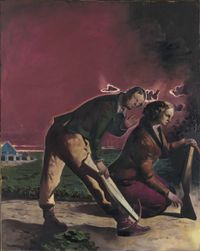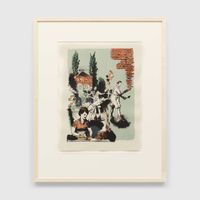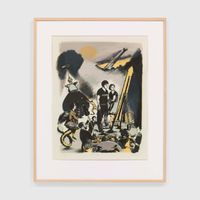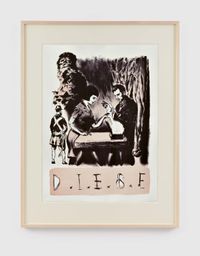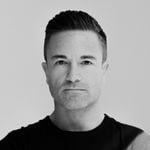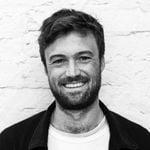Neo Rauch is a figurative painter who specialises in large stretchers of complex narratives, where groups of figures hover within fragmented picture planes and slivers of flat unmodulated colour.
Read MoreExuding dissatisfaction with conventional storytelling, the works combine communist Socialist Realism with Pop art and Surrealism. He is regarded as the leading painter in the New Leipzig School.
After his parents, who were also artists, were killed in a train crash, Rauch was raised in Aschersleben by his grandparents. He now lives near the commercial city of Leipzig, in Markkleeberg, working there in a studio with his wife, artist Rosa Loy.
Rauch studied painting at the same academy as his parents, the Leipzig Academy of Visual Arts, under the supervision of the painter Arno Rink and Bernhard Heisig, the state painter for the Communist regime. Many of his classmates made up the New Leipzig School after Germany was unified, and Rauch worked as a teaching professor at the Leipzig Academy until 2014.
Rauch's hybrid paintings are rich with art historical allusions to different time periods. Using the traditional techniques of classic history painting, they evade logical explanation. The protagonists' bodies, sometimes adorned with symbolic animal heads, horns, tails, or wings, are accompanied by various indeterminate objects and often aligned at strange angles in industrial or landscape settings. The result is disorientating, as if the figures are frozen in mid-action. Examples include Hunt (2002) and Übergang (2003). Some stylistically hint at Jörg Immendorff's use of figures in cafes.
With Rauch, the flickering dreamy light is never atmospheric or murky, but always crystalline sharp. Such clarity makes Rauch's unanticipated juxtapositions all the more unnerving. Whether within their compositional vectors or otherwise, the brightly hued images seem to be allegorical, yet all such tropes remain inconsistent.
Rauch's images attempt to reflect the extreme violence, chaos, and madness of the world we live in. In an interview he has said: 'In my own way I inhale the world around me. It flows into my brush, then reappears, transformed.'
In 2019, a very ugly public disagreement with a critic resulted in a furore that made Rauch decide—despite the increased media attention—to never engage with any reviewer in such fashion again.
Wolfgang Ullrich, an art writer, argued that there was a right-wing bias in the German art scene where reactionary tendencies dominated in opposition to progressive attempts to promote post-colonial and feminist critiques. He claimed Rauch was a leading example of such anti-'politically correct' propagandising.
To this, Rauch, who sees himself as centrist, reacted by painting the critic squatting over a potty, scooping up the contents, and painting a canvas with his own excrement, the subject being a figure giving a Nazi salute. The subsequent commotion resulted with Ullrich writing a book and the work (Der Anbräuner) being auctioned off to raise a large amount of money for charity.
This much lauded, popular, quite traditional painter has had many surveys, and is seen as a symbol of a modern, newer Germany, much more recent and contemporary than say that inhabited by more modernist 'experimental' post war figures like A. R. Penck, Sigmar Polke, or Gerhard Richter.
The artist has participated in the following select solo exhibitions: Neo Rauch: The Signpost, David Zwirner, New York (2021); Neo Rauch: Das Wehr, Landesmuseum Schloss Heidecksburg, Rudolstadt, Germany (2021); Neo Rauch: At the Well, David Zwirner, New York (2014); Neo Rauch: Kunstpreis der Leipziger Volkszeitung 1997, Museum der bildenden Künste Leipzig (1997); Neo Rauch, Galerie am Thomaskirchhof, Leipzig (1989).
The artist has also participated in the following group exhibitions, including Something Living, Art Gallery of New South Wales, Sydney (2017); 4th Moscow Biennale: Rewriting Worlds, Moscow (2011); and 49th Venice Biennale: Plateau of Humankind, Venice (2001).
Neo Rauch's work is held in numerous major collections across the world, including the Museum of Modern Art (MoMA), New York; Goetz Collection, Munich; The Broad, Los Angeles; and Museum Ludwig, Cologne.
On Ocula, the artist is represented by David Zwirner and Galerie Eigen + Art. Recent exhibitions hosted by David Zwirner include Neo Rauch: Blätterrausch Online Viewing Room (2020), 20/20 (2020), and On Painting: Art Basel Online(2020).
John Hurrell | Ocula | 2021
